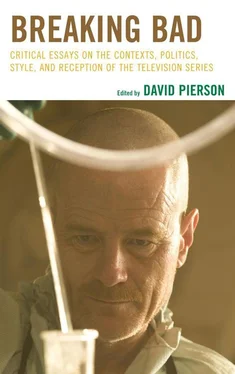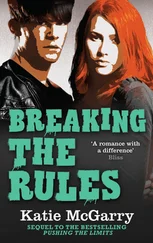Several other minor characters illustrate the fact that not all criminals of Latin origin are involved with the cartels. Hugo Archilleya (Pierre Barrera), the janitor where White teaches high school, is initially suspected of stealing meth-producing equipment from the stock room because he has a prior history with marijuana possession. He is not given the benefit of the doubt in the distinction between drug user and drug dealer, and is led away in handcuffs after the DEA finds a small amount of marijuana in his possession. Although he is, in fact, a dealer, Combo (Rodney Rush) is very much a minor player and not at all piped into the cartel. He is a small-time, street-level meth dealer associated with Pinkman. Even though he has the least screen time of Pinkman’s cronies due to his premature death, Combo is perhaps the most important. He sells his mother’s RV to Pinkman who, along with White, uses the vehicle as a mobile drug lab. The fact that Combo steals the RV in order to sell it later allows Schrader to conclude that Pinkman is connected to the blue meth. It is following Combo’s death, however, that the audience learns that he is Latino. During Schrader’s investigation, it is revealed that Combo’s name is actually Christian Ortega. Combo is light-skinned, light-haired, and has blue eyes, appearing every much as Anglo as Pinkman and their mutual friends Brandon “Badger” Mayhew (Matt L. Jones) and Skinny Pete (Charles Baker). It is thus a surprise when it is revealed that Combo is at least part Latino, as Hollywood typically casts actors with darker hair, eyes, and skin for such characters. [13] Case in point—Although Cameron Diaz grew up speaking Spanish while Jessica Alba did not, it is the darker-complected Alba who is more often cast in Latina roles.
And finally, Tomas Cantillo’s (Angelo Martinez) appearance in the narrative is not at all standard. Heart wrenchingly, the eleven-year-old brother of Pinkman’s girlfriend becomes involved with some rival meth dealers, serving as a lookout and drug dispenser. In the episode “Mandala” (5/17/09), Tomas even shoots Combo after being ordered to by his bosses. The boy’s murder a short time later indicates the vicious cycle that exists, where young men of Latino descent growing up in poverty fall victim to a drug subculture that perhaps offers financial security in the short term, but often ends in death. Tomas’ nephew, Brock Cantillo (Ian Posada), who is only a few years younger, is the next potential victim of this cycle, although his mother, Andrea (Emily Rios), and Pinkman are determined that he will not get involved with this subculture, pushing him to succeed in school.
Although the majority of the Latino characters in Breaking Bad are involved with drug production, transportation, or distribution, there are a few who exist on the other side of the spectrum. Schrader’s partner in the DEA, Steve Gomez (Steven Michael Quezada), does not at all conform to typical stereotypes of Latino males who hold power. He is pacific and nurturing, often sublimating his own career to the needs of those around him. Although they are partners, he takes his lead from Schrader, a tendency that is formalized following the latter’s promotion. Indeed, the only times Gomez seems to take the initiative are when he leads a gang of DEA agents as well as White to gloat over the grievous wounds suffered by the surviving Salamanca cousin, and when he accepts a promotion to the El Paso office. However, these moments have less to do with his character development and more to do with, respectively, getting White into the same room with Salamanca and developing a wedge between him and Schrader. It is the latter, in many ways, who most closely matches the traditional notion of Latino machismo during the course of the series. Although he is an Anglo character, Schrader swaggers through the narrative (at least in the first two seasons), taking immediate charge of every single encounter, bragging about his own abilities, and dispensing ribald and even racially-tinged insults to his co-workers. He is the alpha male of the Albuquerque DEA and is portrayed as a stereotypical machismo Latino character. [14] Hank’s quest for social dominance in the DEA office reflects the structuring of the Mexican patriarchal order. In Modernity and the Nation in Mexican Representations of Masculinity (2007), Hector Domínguez-Ruvalcaba notes that Mexican machismo is an outgrowth of the class system in Spanish colonialism. In a nation where skin color and surname no longer carry the meaning they once did under Spanish rule, aggression and dominance are tools of establishing and preserving the social order. As Domínguez-Ruvalcaba states: “Mexican masculinity is an invention of modern colonialism, in which sensualizing means disempowerment” (3). He also notes the homosocial nature of Mexican culture, linking it specifically to machismo. In Mexico, during male-male intercourse the passive recipient is the only partner to be considered homosexual. As actor Gael Garcia Bernal noted while promoting Y tu mamá también (2001) in 2002: “It’s a Mexican idiosyncrasy… you’re more macho if you fuck men” (quoted in de la Mora, 12). Hank uses jokes, taunts, and nicknames to objectify those around them and re-inscribe their place below him in the hierarchy. In so doing he typifies the specific flavor of machismo described by Domínguez-Ruvalcaba and other critics.
Although Schrader is a dedicated husband, he is all about competition and even social dominance. Indeed, Schrader’s machismo takes his character in interesting directions and asserts him as one of the narrative’s most interesting characters. Although he is Anglo, his is the character that best elucidates the complexities of border machismo throughout the narrative.
Agent Schrader’s machismo attitude is first challenged when he is damaged psychologically in the episode “Negro y Azul” (4/19/09), and later when he is physically devastated in the episode “One Minute” (5/2/10). In the former episode, Hank joins a rowdy group of El Paso DEA agents in a cross-border task force set to monitor Tortuga as he gains information about the drug cartel. Schrader is out of his element in that he is a newcomer to a team of alpha males with an already established pecking order. Furthermore, he does not speak Spanish, making it difficult for him to communicate with the Mexican cops assigned to the task force. He knows that other members of the team are making fun of him in Spanish but finds himself unable to retort. Things go from embarrassing to traumatic, however, when Tortuga’s decapitated head is found attached to a tortoise. Schrader walks off to vomit, enduring the scorn of both DEA agents and Mexican police alike but ironically saving his life when a grenade hidden within Tortuga’s head explodes. As Schrader runs past several dead bodies to use his belt as a tourniquet for a fellow agent whose leg has been severed, the scene cuts away to a photograph of an atomic explosion at the National Museum of Nuclear Science and History, where Pinkman is meeting with his dealers. Indeed, this episode does have an explosive effect within Schrader’s consciousness; for the rest of the season and into the next, he suffers from Post Traumatic Stress Disorder and no longer acts the macho alpha male to quite the same degree. He is still recovering from this episode and beginning to re-assert his dominance in the Albuquerque office when he is exposed to an even more severe event in “One Minute.” In order to protect White from the Salamanca cousins, Fring reveals to them that it was Schrader who killed their cousin Tuco. In order to give Schrader the advantage, Fring makes an anonymous phone call to the DEA agent just before the attack. What he does not realize, however, is that Schrader had just been put on administrative leave and thus does not have a firearm. What transpires is a battle during which one Salamanca brother is killed, another badly injured, and Schrader shot four times. As one of the bullets lodges near his spine, for the rest of season three and throughout much of season four, Schrader is bed-ridden and must rely upon his wife, Marie (Betsy Brandt), for even the most simple tasks. For a man of his confidence and braggadocio, having to learn how to walk again and needing assistance to go to the bathroom is devastating, and his convalescence is as much psychological as it is physical. The traumas that attend a border culture predicated upon the drug trade make it difficult to maintain the machismo typically associated with this region. Breaking Bad finds an additional avenue of destroying Latino stereotypes in having an Anglo character so obviously manifest one of the overarching ones.
Читать дальше












